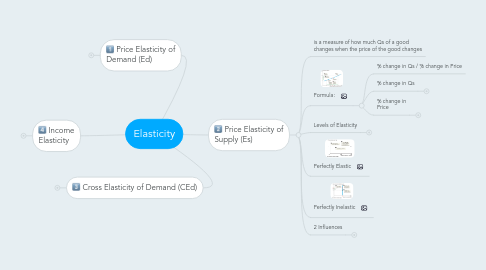
1. Price Elasticity of Demand (Ed)
1.1. is a measure of how much Qd of a good changes when the price of the good changes.
1.2. Formula:
1.2.1. % change in Qd / % change in Price
1.2.2. % change in Qd=
1.2.2.1. [(New Qd - orig. Qd) / (New Qd+orig. Qd)/2] x 100
1.2.3. % change in Price=
1.2.3.1. [(New price - orig. price) / (New price+orig. price)/2] x 100
1.3. Levels of Elasticity
1.3.1. Elastic
1.3.1.1. When Ed > 1
1.3.2. Unit Elastic
1.3.2.1. When Ed = 1
1.3.3. Inelastic
1.3.3.1. When Ed < 1
1.4. Demand Curve
1.4.1. Elastic at any price above midpoint (B)
1.4.2. Unit elastic at midpoint (B)
1.4.3. Inelastic at any price below B
1.5. 2 Influences:
1.5.1. Availability of substitutes
1.5.1.1. Readily available
1.5.1.1.1. Elastic
1.5.1.2. Hard to find
1.5.1.2.1. Inelastic
1.5.1.3. The longer the time elapsed since price change
1.5.1.3.1. = more elastic demand
1.5.1.4. How good is defined
1.5.1.4.1. Narrow
1.5.1.4.2. Broad
1.5.2. Proportion of income spent
1.5.2.1. The greater the %, the more elastic
1.6. Relationship to Total Revenue(TR)
1.6.1. TR = Price x Quantity
1.6.2. If elastic
1.6.2.1. a given % rise in Price
1.6.2.1.1. creates a larger % decline in Qd
1.6.2.1.2. Total Revenue decreases
1.6.2.2. Price & TR change in opposite directions
1.6.3. If inelastic
1.6.3.1. a given % rise in Price
1.6.3.1.1. creates a smaller % decline in Qd
1.6.3.1.2. Total Revenue increases
1.6.3.2. Price & TR change in same direction
1.6.4. If unit elastic
1.6.4.1. when Price change doesn't change TR
2. Cross Elasticity of Demand (CEd)
2.1. is a measure how much the demand for a good changes when the price of a substitute or complement changes
2.2. Formula
2.2.1. % Change in Qd / % change in Price of Substitute/compliment
2.3. CEd for Substitute
2.3.1. if positive
2.3.1.1. a fall in Price of substitute causes a decrease in Qd
2.3.1.2. Qd of good & Price of substitute change in same direction
2.4. CEd for Compliment
2.4.1. if negative
2.4.1.1. a fall in the Price of a complement causes an increase in Qd of the good
2.4.1.2. Qd of good & Price of substitute change in opposite directions
3. Income Elasticity
3.1. is a measure of how much demand for a good changes when income changes, other things remaining the same.
3.2. Formula
3.2.1. % Change in Qd / % Change in Income
4. Price Elasticity of Supply (Es)
4.1. is a measure of how much Qs of a good changes when the price of the good changes
4.2. Formula:
4.2.1. % change in Qs / % change in Price
4.2.2. % change in Qs
4.2.2.1. [(New Qs-orig Qs) / (New Qs+orig Qs)/2] x 100
4.2.3. % change in Price
4.2.3.1. [(New Price-orig Price) / (New Price+orig Price)/2] x 100
4.3. Levels of Elasticity
4.3.1. Elastic
4.3.1.1. % change in Qs > % change in Price
4.3.1.2. Es > 1
4.3.2. Unit Elastic
4.3.2.1. % change in Qs = % change in Price
4.3.2.2. Es = 1
4.3.3. Inelastic
4.3.3.1. % change in Qs < % change in Price
4.3.3.2. Es < 1
4.4. Perfectly Elastic
4.5. Perfectly Inelastic
4.6. 2 Influences
4.6.1. Production possibilities
4.6.1.1. Elastic
4.6.1.1.1. goods produced with constant opportunity cost
4.6.1.2. Inelastic
4.6.1.2.1. goods produced in fixed quantity
4.6.2. Storage possiblities
4.6.2.1. Elastic
4.6.2.1.1. storable goods
4.6.2.2. Inelastic
4.6.2.2.1. non-storable goods
